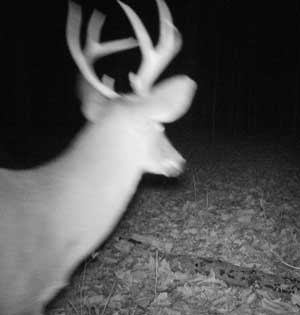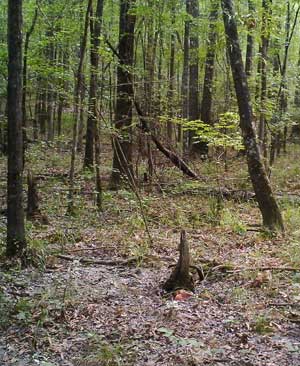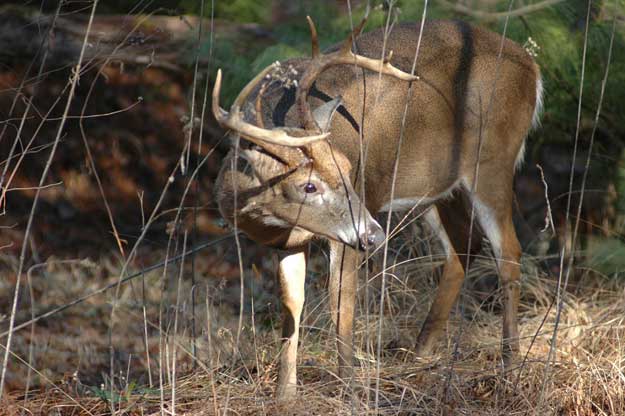Austin Delano with Mossy Oak BioLogic shares 5 great tips for getting good trail camera pictures, which includes how trail cameras work in certain situations, how to mount trail cameras, preferred locations for setting up trail cameras, how often trail cameras need to be checked and how to attract deer for good photos.
1. Trail Camera Quick Tips
Some quick trail camera tips to ensure better pictures are simple things like facing the camera north, using high-quality batteries and memory cards and researching before buying.
If your trail camera is facing east or west, the sun can cause the pictures to be washed out or create false triggers. So be sure your camera is facing north with a clear background.
The last thing you want is cheap batteries exploding in your high-dollar trail camera, so buy the good kind. With cheaper memory cards, often the pictures don’t write onto the card very well. For higher quality photos, the better the card the faster it writes.
It’s always good to check out trail camera reviews to get the best camera for your needs and know which ones take the best photos. Some have great features like smartphone capabilities that allow you to view the photos from your phone. If you’re far from your hunting location and can’t check the camera as you’d like, this is a great feature.
2. Trail Camera Settings
Today’s trail cameras have a ton of options that you can set up specifically for your location and situation. If you’re setting it up over deer bait like corn or a mineral lick, turn your frequency and sensitivity down so you don’t end up with a lot of photos of the same thing. This fills your card and uses up your batteries.
If you’re using your camera over a deer scrape, trail or opening of a food plot, turn the frequency and sensitivity up so that you catch everything that moves through. Unlike baited deer that will stay in one spot, you’re trying to see how, when and where they move through so you can learn deer patterns.
3. Setting Up Trail Cameras
 Don’t just pick a random tree and throw up a camera. It’s important to have a strategy when placing your trail camera.
Don’t just pick a random tree and throw up a camera. It’s important to have a strategy when placing your trail camera.
If you have an idea where the deer are moving but there’s not a tree there, you may need to improvise. Pay attention to creek crossings and food sources where you can catch deer moving. You may need to set up a post and camouflage it as necessary.
Mounting tips
If the deer camera is mounted too low, it can limit the field of view. It should at least be head high if not higher. This keeps the camera higher off the ground in case of flooding and allows you to angle it down some for a wider field of view to pick up more movement. Most trail cameras shoot best between 10 and 20 feet. You don’t want the flash too close to the deer or the picture will be blown out and too far away, it won’t be clear enough.
It’s also a good idea to camouflage your mounted camera with surrounding brush so potential trespassers don’t see and to keep from spooking deer. Just make sure no limbs or leaves are in the field of view.
4. How Often Should I Check My Trail Camera?
 The location of your camera has a lot to do with how often you check it. You don’t want to disturb bedding areas and food sources too frequently. You don’t want to spook the deer. If you go too often, you are leaving your scent behind and educating the deer on your travel patterns. If you have a row crop field, it won’t hurt to go check your trail camera every couple of weeks.
The location of your camera has a lot to do with how often you check it. You don’t want to disturb bedding areas and food sources too frequently. You don’t want to spook the deer. If you go too often, you are leaving your scent behind and educating the deer on your travel patterns. If you have a row crop field, it won’t hurt to go check your trail camera every couple of weeks.
5. Best Way to Attract Deer to Your Trail Camera
There are a lot of good deer attractant options on the market. When you put your bait out, it needs to be where the deer already want to be. Near a food plot, food/water source or bedding area are great places to add bait for deer. You just want to encourage them to stop.
Chestnut Magic is a simple blend of ground and whole chestnuts and rice bran, and it works great near heavily browsed and traveled areas.
Regardless of what you use, and don’t be afraid to try new attractants, location is key for baiting deer. The location of a game camera on your property also plays a huge role in capturing more and better trail camera wildlife photos. Check out this article Trail Cam Location Strategies: Monitoring Your Bucks for great info and tips for trail camera placement.



























